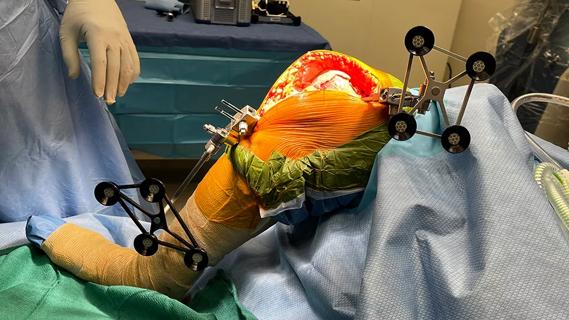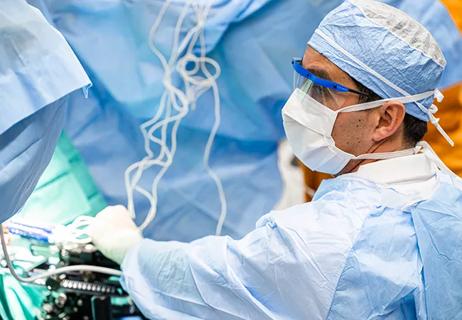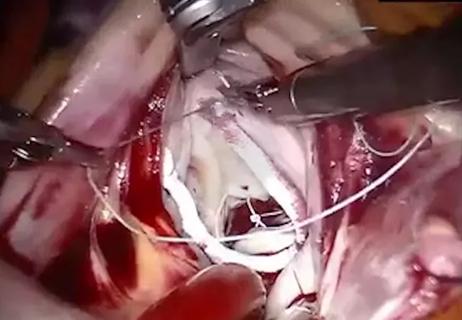Advertisement
Why urologic oncologists favor the technique for select patients

Testicular cancer has a five-year survival rate of approximately 95%, a result of remarkable advances in treatment. This shift has enabled newer approaches that are improving morbidity and longer-term quality of life. This is particularly important in this relatively younger patient population, many of whom are diagnosed in their 20s or 30s.
Advertisement
Cleveland Clinic is a non-profit academic medical center. Advertising on our site helps support our mission. We do not endorse non-Cleveland Clinic products or services. Policy
Radical inguinal orchiectomy is the gold standard for the initial treatment and diagnosis in most cases where there is suspicion of malignancy in the testis. However, in cases where cancer has potentially spread to the retroperitoneal lymph nodes, a common location for metastases of testicular cancer, urologic oncologists may opt for primary or salvage retroperitoneal lymph node dissection.
The location of the nodes — behind the intestines but in front of the spinal column—make access difficult. In addition, a very controlled operative field is essential because these lymph nodes are between and around the two largest blood vessels in the body. Using the traditional open approach is the gold standard and yields good long term outcomes but has shortcomings in the perioperative period, including significant pain, five to seven days to discharge, and a large midline incision from where the ribs meet below the sternum nearly to the pubic bone.
Advancements in robotic surgery technology and the development of advanced surgical skills led to the development of a new approach, robot-assisted retroperitoneal lymph node dissection (RPLND). This new approach appears to offer excellent cancer outcomes, but a vastly improved recovery and is becoming a preferred option among Cleveland Clinic urologic oncologists for select patients.
In an episode of Cleveland Clinic’s Cancer Advances podcast. Christopher Weight, MD, Center Director of Urologic Oncology at Cleveland Clinic, discusses the approach and offers insight on the following:
Click the podcast player above to listen to the 20-minute episode now, or read on for a short edited excerpt. Check out more Cancer Advances episodes at clevelandclinic.org/podcasts/cancer-advances or wherever you get your podcasts.
Podcast host Dale Shepard, MD, PhD: You mentioned that patients with testicular cancer, they have a really good survival rate. We’re really trying to do what we can to minimize really harm from their treatments. What do you think, with this technique, with robotic surgeries, what do you think have been the biggest wins?
Advertisement
Dr. Weight: I think the recovery is remarkably faster. In the United States, the average patient spends about five to six days in the hospital after surgery, and then about six weeks before they report feeling back to normal. Our average patient with this minimally invasive robotic approach has spent one day in the hospital.
And so I think the total recovery time is much quicker. And we’ve also had a slightly lower rate of chylous ascites. Part of this could be selection, because those patients have a lower risk of chylous ascites. But also we have about five to 10-fold magnification, and so we may be able to see the lymph vessels a little bit more clearly and better control them with clips—but that remains to be seen.
Dr. Shepard: What are the gaps? Do you still see some room for improvement?
Dr. Weight: I think there’s still some opportunities to broaden this approach to a wider audience. For example, in Stage 1b, there’s a significant risk of relapse and about a 50% chance that the tumor is going to come back—and we know we can lower that by RPNLD. We didn’t often offer it that way and really encourage surveillance because the open RPLND is a significant procedure to undergo and often puts people out for six weeks.
But also, many of these young men are in very transient phases of life where they’re changing where they’re living, they’re in college, they’re changing jobs frequently, they’re on their parents’ insurance, then they’re off their parents’ insurance. And we’ve actually always known that surveillance and follow-up on testis cancer patients has always been a challenge because of some of those logistical details.
We also need to figure out how to utilize the surgery more effectively in the post-chemo setting and safely and into patients with obesity. This remains a challenge in that those patients may not be eligible for the surgery, but stand to benefit the most because of a higher risk of wound complications, which are far higher when you have an open incision compared to minimally invasive incisions.
Advertisement
Advertisement

Study finds that fracture and infection are rare

A newer modality for select patients has shown positive outcomes to date

Cleveland Clinic screening tool yields results comparable to those with sternotomy

Polygenic risk score could help predict who will develop this aggressive breast cancer

New guidelines offer insight into emerging therapies, dental issues and more

Clinical trial to assess the value of nutritional, physical therapy and social supports prior to preoperative chemotherapy

Research demonstrates improved overall survival for patients receiving comprehensive treatment for breast cancer in addition to radiation or surgical intervention for brain cancer

Platinum-eligible phase 3 trial of enfortumab vedotin and pembrolizumab yields ‘unprecedented data’